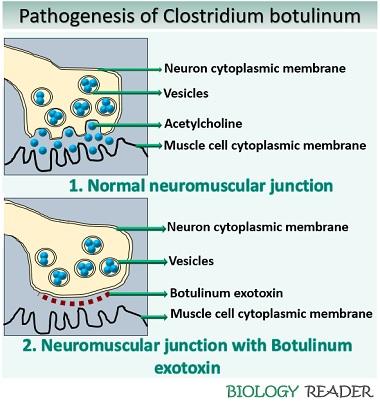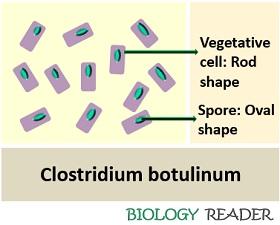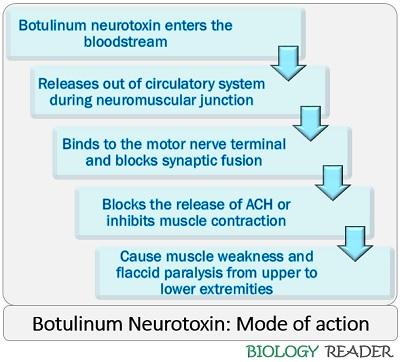Clostridium botulinum is a clinically significant bacteria, which causes a sporadic but severe disease called “Botulism”. It produces a particular type of exotoxin that affects the nervous system by inhibiting the neuromuscular junction’s activity. Therefore, the botulinum toxin behaves as a neurotoxin, which blocks the release of a neurotransmitter (acetylcholine).
Acetylcholine is a chemical compound made by the combination of choline and acetyl Co-A, which gives the chemical signal to perform a physical activity like muscle contraction. Without the release of ACH or Acetylcholine, there will be no muscle contraction or movement, which means a body become paralyzed.
Clostridium botulinum causes flaccid paralysis, which starts from the upper extremities to the body’s lower extremities. C. botulinum bacteria are gram-positive, rod shaped and obligate anaerobes (oxygen acts as a poison). It most usually causes three kinds of botulism, namely foodborne, wound and infant botulism. Among these three types, foodborne botulism is very common.
Content: Clostridium botulinum
Definition of Clostridium botulinum
Clostridium botulinum belongs to the group of pathogenic bacteria, which produces a highly potent exotoxin that causes botulism disease. They exist as anaerobic, gram-positive, rod-shaped and spore-forming bacteria. Clostridium botulinum is widely distributed in the world. The spores of C.botulinum are ubiquitous but most commonly found in soil and marine sediments. C.botulinum spores can enter the body in two ways:
- By the ingestion of spores through food contaminated with the presence of C.botulinum.
- A bacterium could also enter through a wound or the mucosal surface of the skin.
Once a bacterium enters the body, it first causes gastrointestinal symptoms after 24-36 hours of ingestion. A bacterium goes through the maturation phase and produces an exotoxin that causes cranial nerve dysfunction within 3-7 days.

Further, C. botulinum obstructs muscle contraction by inhibiting acetylcholine synthesis and resulting in the paralysis of involuntary muscles. An exotoxin causes “Flaccid paralysis” by blocking the motor nerve terminal to synthesize acetylcholine at the neuromuscular junction. The progression of the disease is in a downward fashion, which means it would initially affect the eyes, face, throat, chest and other lower extremities.
Distribution
Spores of C. botulinum are worldwide in distribution and are saprophytes. The strains of C. botulinum have a wide range of habitat, and they are commonly present in the soil, the skin of fruits and vegetables, hay, silage, animal manure, sea mud etc.
History
The origin of C. botulinum was evolved after a major outbreak occurred in the year 1735, after eating German sausages. After C. botulinum origination, many scientists studied its phenotypes, serotypes, pathogenicity, and applications etc.
| Year | Discoverer | Discovery |
|---|---|---|
| 1870 | Muller | Derived the name Botulism from the Latin word “Botulus” which means sausage. |
| 1895 | Emile Van Ermengem | First isolated C.botulinum from a piece of ham, caused major outbreaks |
| 1944 | Dr Edward Schantz | First isolated botulinum neurotoxin |
| 1949-1950 | - | Studied the effect of Botulinum toxin (Botox) on the nervous system, which blocks the neuromuscular junction by blocking acetylcholine. |
| 1980 | Dr Alan B. Scott | Used neurotoxin to treat strabismus |
| 1989 | - | US, FDA approved the use of Botox for the treatment of strabismus |
| 2002 | - | FDA approved the use of Botox in cosmetic improvement to treat wrinkles, frown lines etc. |
Morphology of Clostridium botulinum
The morphological characteristics of C. botulinum include:

- Shape: C. botulinum possesses a rod shape.
- Size: A bacterium measures a length of 1.6-22.0 mcm and width of 0.5-2.0 mcm.
- Colour: A bacterium appears violet coloured on gram staining, as C. botulinum gives a positive gram reaction.
- Presence of capsule: They lack the presence of an extracellular capsule, i.e. C. botulinum strains are “Non-capsulated”.
- Genome size: The genome size of C. botulinum is about 3.89 Mb.
- Motility: Clostridium botulinum bacteria are generally motile by having peritrichous flagella.
- Spores: C. botulinum bacteria produce exospores during reproduction, i.e. they are “spore formers”. The spores of C. botulinum are heat and light-resistant, i.e. they can survive for several hours at 100 degrees Celsius and 10 minutes at 120 degrees Celsius. Spores generally appear oval-shaped, bulging, subterminal in position and remain dormant for 30 years or more.
Classification
Based on serological specificity, C. botulinum produces the following serotypes:
- A, B, C1, C2, D, E, F and G serotypes.
Except for C2, all the serotypes produce exotoxin that serves as a neurotoxin that affects the nervous system. Type C2 acts as an enterotoxin that affects the gastrointestinal system. Based on physiological and biochemical properties, there are four phenotypic groups of C. botulinum (Group I, II, III and IV).
| Group of Clostridium botulinum | Toxin types | Proteolysis | Lipolysis | Saccharolysis | Minimum growth temperature ( ֯ C) | Optimum growth temperature ( ֯ C) | Salt inhibition (in %) | Pathogenicity |
|---|---|---|---|---|---|---|---|---|
| I | A, B, F | + | + | + | 12 | 35-40 | 10 | Human botulism |
| II | B, E, F | - | + | + | 3.3 | 18-25 | 5 | Human botulism |
| III | C1, C2, D | - | + | + | 15 | 40 | 3 | Animal botulism |
| IV | G | + | - | - | Not known | 37 | >3 | Not known |
Growth Conditions
The spores of C. botulinum can resist extreme conditions, and their growth requires the following environmental conditions:
- C. botulinum does not require oxygen presence.
- C. botulinum grows within the mesophilic temperature range.
- Generally grows in low acidic, low sugar and low salt substrates like meat, fish, egg, beans, apricots etc.
Thus, the effect of botulinum exotoxin can be detoxified by subjecting it to high heat (100 degrees Celsius for 10 min), high acidity, high sugar and high oxygen environment.
Virulence Factor
Clostridium botulinum bacteria are classified among the group of pathogenic bacteria because they produce exotoxins that cause botulism. Exotoxins serve as a virulence factor, which causes disease in mammals like humans, animals etc. In the absence of exotoxin, Clostridium botulinum bacteria are considered non-invasive or non-infectious.
Clostridium Botulinum Toxin
The different groups of Clostridium botulinum synthesize exotoxins that serve as non-toxic protoxins or progenitor toxins. Trypsin activates the exotoxins and the other proteolytic enzymes. In the pure crystalline state, botulinum exotoxin is considerably the most potent or fatal substance known to humankind.
The exotoxin has a molecular weight of 150 kDa. Generally, botulinum exotoxin is a neurotoxin that disrupts the nervous system’s normal functioning and results in paralysis of involuntary muscles. A lethal dose for mice is 0.000,000,033 mg and 1-2 µg for human.
Characteristics of Botulinum Exotoxin
- Stability: A toxin produced by Clostridium botulinum is a relatively stable compound. Botulinum exotoxin remains stable under acidic condition (>4.6) and dissociates under alkaline conditions.
- Chemistry of Botulinum exotoxin: Initially exists as a single inactive polypeptide chain of molecular weight 150 kDa and lacks a leader sequence. The protease enzyme functions to cleave the neurotoxin into active di-chain neurotoxins.
- Molecular structure: An exotoxin possesses one heavy and one light chain of molecular weight 100 kDa and 50 kDa, respectively. The di-sulphide bond associates the heavy and light chain. Botulinum exotoxin contains one atom of zinc. The di-sulphide bond present between the heavy and light chain mediates the neurotoxin to penetrate the cell.
- Absorption: Small intestine is a site, which mainly absorbs the botulinum exotoxin (in an active form).
- Uniqueness: It is unique from the other exotoxins, as it is released after the cell lysis.
- Isolation: By employing ion-exchange chromatography, one can isolate the botulinum exotoxin.
- Effect: Botulinum neurotoxin blocks ACH synthesis (Acetylcholine) at the synapses and neuromuscular junction and results in paralysis. In severe illness, the exotoxin leads to respiratory paralysis, which eventually causes death. A neurotoxin is zinc endopeptidase, which cleaves the membrane protein of synaptic vesicles (synaptobrevin).
- Toxin inactivation: The temperature of 80 degrees Celsius for 30-40 minutes and at 100 degrees Celsius for at least 10 minutes can cause toxin inactivation.
Pathogenesis
Botulinum toxin obeys the following pathogenesis pathway:

- Initially, botulinum toxin gets absorbed into the bloodstream.
- A toxin releases at the time of attachment of the neuron with the muscle cell. It releases out from the cytoplasmic membrane of the muscle cells.
- The exotoxin binds to the motor nerve terminal and does not allow the fusion of synaptic vesicles. Thus, a toxin blocks the release of acetylcholine that is necessary for nerve impulse and muscle contraction.
- As a result, there will be no muscle contraction, which consequently causes paralysis of the muscle fibre.
Therefore, botulinum toxin primarily affects the cranial nerves and later causes symmetrical descending flaccid paralysis from upper to lower extremities.
Important Facts of Clostridium botulinum
Some interesting facts of Clostridium botulinum are:
- Clostridium botulinum produces a protein with specific neurotoxicity, which refers to the “Neurotoxin”.
- C. botulinum causes a severe disease, “Botulism” through the ingestion of food encountered the attack of C. botulinum.
- A pathogenic C. botulinum causes botulism (a type of food intoxication).
- C. botulinum causes botulism, which is rare, but its mortality rate is very high.
- Among all the serotypes of botulinum neurotoxins, type-A is more toxic.
- The antigenicity of C. botulinum has been studied after the complete neutralization of toxins by homologous antitoxins.
- Serotypes C and D produce more than one toxin and can cross-react with antitoxins.
- Botulinum exotoxin produces at the time of sporulation only.
- C. botulinum requires an optimum temperature of 35 degrees Celsius to produce proteolytic exotoxins and requires 26-28 degrees Celsius to produce a non-proteolytic type.
- C. botulinum starts showing neurological symptoms after 12-36 hours of ingestion. Sometimes, it may take several days to produce visible signs. Shorter in the incubation period, more severe is the illness and high mortality rates.
Treatment
- Foodborne botulism: To treat foodborne botulism, a doctor could prescribe you to take antitoxins that can block the activity of exotoxin. In case of respiratory failure, a mechanical ventilator is suggested.
- Infant botulism: For infant botulism, a health physician may recommend enemas to remove the contaminated food.
- Wound botulism: To treat this, one could administer antitoxins to neutralize the effect of exotoxins. In addition to this, surgical debridement and excision of the affected area can also be employed.
Significance
Clostridium botulinum is a medically important bacteria, which causes severe disease ‘Botulism’. It is used to prepare or produce medicaments like botox, Dysport etc., to relieve muscle pain. Botulinum exotoxin can be used as a bioweapon for biowarfare and bioterrorism and in the cosmetic industry to remove the glabellar lines.